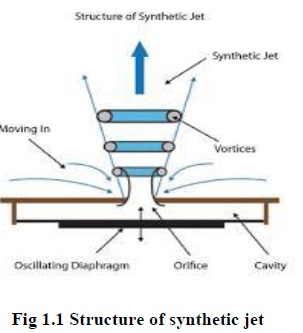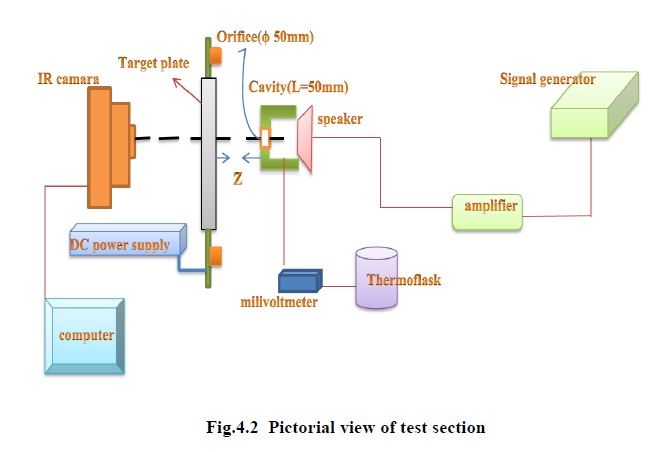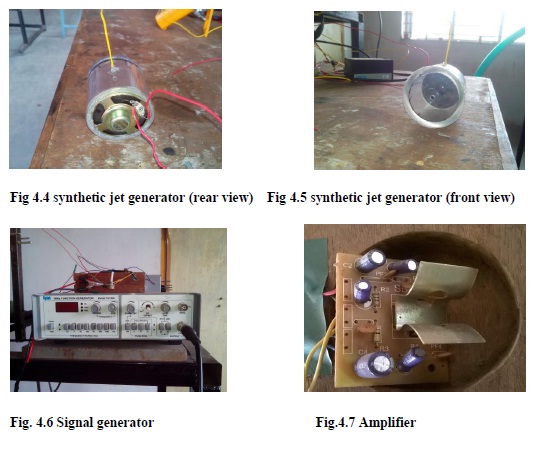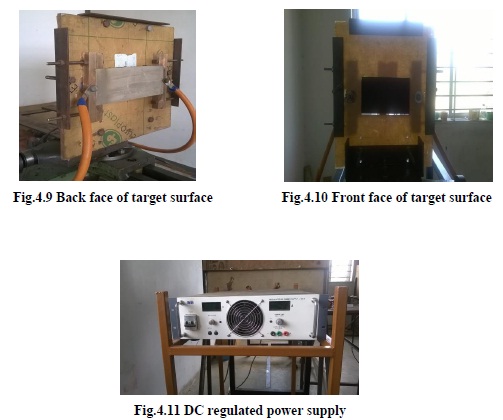





Published on Nov 30, 2023
Synthetic jet is a relatively new technique which synthesizes stagnant air to form a jet resulted from periodic oscillations of a diaphragm in a cavity. Synthetic jet actuator is composed of a closed cavity with one end covered by electromagnetic actuator and a circular orifice at other end. Usually the jet is formed due to the entrainment of the vortex pairs which are rotating in opposite direction and formed at the edges of the orifice. They have promising application in various fields such as jet vectoring, electronics cooling, and boundary layer separation. In present work the synthetic jet is driven by acoustic speaker for the impingement of jet on the heated surface. The temperature distribution across the heated surface is measured with the help of infrared thermal camera. The local heat transfer study of synthetic jet for effective cooling on flat surface in terms of Nusselt number and Heat transfer coefficient by varying parameters such as excitation frequency (60 Hz to 180 Hz), axial distance between target plate and orifice plate (Z/d= 1 to 12) with maintaining constant ratio of cavity length to cavity diameter is equal to unity, i.e. L/D=1throughout work
The results show that at 160Hz frequency for the axial distance and diameter ratio in between of 5-6, the cooling is very effective. The Nusselt number is peak at stagnation point for all frequencies and attenuates monotonically in the radial direction. The results are expected to be helpful for the development and designing of the synthetic jet.
Nowadays in the present world, there is a great demand for the electronic devices which are compact in size, occupying less space in system etc. This in turn poses a serious challenge in cooling the electronic devices due to the increase in heat generation coupled with the limited heat removal surface area. Thermal issues exist over a wide range of power dissipation levels from handheld devices that dissipate a few Watts to high-performance microprocessors dissipating over 100W. The engineers came up with some solutions like Heat sinks, forced air cooling (fans), heat pipes which are traditional cooling methods. But still they have some drawbacks, such as the heat sinks needs to have smooth and flat surface for better heat dissipation, which costs more for fabrication; forced air cooling (fan) requires more space in the system; heat pipes are hollow metal tubes which contains thermal liquid in it, which has got the chances of damaging the system. To overcome these drawbacks, synthetic jet can be potentially used for cooling applications.
The local heat transfer characteristics of impingement of a synthetic air jet are studied in this work. Impinging synthetic air jets can be used to transfer heat in diverse applications, which may vary from the cooling of a manufacturing process to the thermal management of electronics, in particular microprocessors, graphic cards etc. While these steep cooling requirements have prompted the study and development of synthetic air jets. It is well known that a jet generates sound, conversely the opposite is also true: sound can generate jets. This phenomenon is known as acoustic streaming.
A nominally plane turbulent jet is synthesized by the interactions of a train of counter- rotating vortex pairs that are formed at the edge of an orifice by the time-periodic motion of a flexible diaphragm in a sealed cavity ([1]Smith and Glezer). A synthetic jet is a flow that is synthesized directly from the surrounding fluid in which a system is embedded. A synthetic jet is commonly formed when fluid is alternately sucked into and ejected from a small cavity by the motion of a diaphragm bounding the cavity. Jet further includes a mechanism in or about the cavity for periodically changing the volume within cavity so that a series of fluid vortices are generated and projected out to an external environment from the orifice. The volume changing mechanism can be any suitable mechanism. Preferably, the volume changing mechanism is implemented by using a flexible diaphragm as a wall of the cavity.
A control system is utilized to create time-harmonic motion of the diaphragm. As the diaphragm moves into cavity, the volume of cavity decreases and fluid is ejected from the cavity through the orifice as the fluid passes through the orifice; the flow separates at the sharp edges of the orifice and creates vortex sheets which roll up into vortices. These vortices move away from the edges of the orifice under their own self- induced velocity. This is important because as the diaphragm moves outward with respect to the cavity. Increasing the cavity volume, ambient fluid is drawn from large distances from the orifice into the cavity. Since the vortices are already removed from the edges of the orifice they are not affected by the ambient fluid being entrained into the cavity. As the vortices travel away from the orifice, they synthesize a jet of fluid through entrainment of the ambient fluid. So, that there is no net mass addition to the system. Due to this feature the need of complex piping or packaging of the system gets eliminated.
Synthetic jet is new technique which generates the jet using surrounding fluid in which it is embedded. Synthetic jets operate on a simple principle; a flexible membrane forms one side of a partially enclosed chamber. Opposite to the membrane is an opening, such as an orifice. A electric magnetic actuator diaphragm causes the membrane to oscillate and periodically force air in and out of the opening. As the jet hits the sharp inner and outer edges of the orifice, the jet gets adverted and the vortex formation takes place. This result in a nonzero mean stream wise pulsating jet formed in front of the orifice which can be directed at a heated surface to enhance cooling.

In the present study, an electromagnetic actuator (acoustic speaker) of diameter 55 mm and operating at an input voltage (Vspeaker) of 4 V is employed. The experiments are conducted for 4mm orifice diameter; cavity diameter (D) and length (L) are 50mm each. i.e. L/D=1 throughout the experiment. The input voltage to the actuator is maintained constant and the frequency of excitation is controlled by a signal generator and monitored by using a knob present in sine/signal generator. The jet issuing from the circular orifice impinges normally onto the target plate at a distance of z from the orifice. The distance between the orifice surface and the target plate is varied with the help of a traverse stand. the influence of diameter of orifice, distance between the orifice surface and the target plate (Z/d) and the frequency (60 to 180 Hz) of excitation of synthetic jet generator on local heat transfer characteristics has been evaluated experimentally by measuring the surface and ambient temperatures for different operating frequencies and other geometric parameters for a known power supplied to the heater. The results are presented in terms of the local heat transfer coefficient and local Nusselt number.
The main elements of the experimental set up are synthetic jet generator, target plate and infrared thermal camera. The fig.4.2 shows the schematic diagram of experimental set up. The other constituents of the set up are DC power supply, milivoltmeter, amplifier, DC regulated voltage supplier and signal generator. A part of experimental set up consisting the synthetic jet assembly, target plate and infrared thermal camera are mounted on table. The synthetic jet assembly is fixed over table by using rod as a fixture. While the target plate is mounted on the 2-D table over the base table which in turn facilitates in adjusting the axial distance between the orifice jet and the heated surface. The target plate which is a thin stainless steel foil with thickness 0.05mm is heated by supplying power through DC power supply. The power can be varied through multi-turn voltage setting knob.
Three and half digit voltmeter and ammeters gives the accurate and precise measurements. The heat to the target plate is supplied through copper bar which provides constant heat flux to the surface. A calibrated K type thermocouple wire is used to measure the jet temperature which is inserted into the synthetic jet generator cavity. Sufficient care must be taken so that only thermocouple junction is protruding inside the cylinder and flow should not be disturbed much. Another K type thermocouple wire is connected to heated surface to measure the surface temperature. Opposing one face (back face) of the target plate infrared thermal camera is mounted in order to get a perfect view of the zone of action and to the other face(front face) the synthetic jet assembly for impingement of jet. In the present experiment an electromagnetic actuated membrane is used as the oscillating diaphragm for the synthesis of a synthetic jet.

Power to the target plate is supplied through the DC power supply in order to heat the target plate. The heat flux supplied to the target plate can be controlled by adjusting the input knob in the DC power supply and then the system is let to reach a steady state condition. The power is supplied to the synthetic jet generator through AC regulated voltage supplier. The input voltage to the acoustic speaker is set using the knobs present over the AC regulated voltage supplier and maintained constant. The required excitation frequency is obtained by setting the knobs over the signal generator. Amplifier is connected to the signal generator to amplify input signal to the acoustic speaker. By the help of the 2D table the axial length between target plate and synthetic air jet is varied. The temperature distribution over the target plate is measured by taking the image of target plate through infrared thermal camera.
The synthetic jet generator which is mounted on stand is schematically shown in fig The synthetic jet generator consists of cavity of dimensions (Di=50mm, L=50mm) whose one end is covered with oscillating electromagnetic actuator i.e. acoustic speaker of 50mm diameter in size and other end is covered with orifice plate of circular of diameter 4mm. The acoustic speaker is connected to amplifier which filters the signal, signal generator is used to generate the sinusoidal signal and excitation frequency by using the knobs. Input voltage (4V) to acoustic speaker is maintained constant by using DC regulated power supply. A calibrated K type thermocouple wire, which is inserted in synthetic jet generator cavity and sufficient care must be taken so that only thermocouple junction is protruding inside the cylinder and flow is not disturbed much.

The Target plate assembly is mounted on 2D table to get required Z/d ratio. Target plate of dimensions (80mm*120mm*0.06mm) of stainless steel foil is used as target plate. Foil is clamped tightly and stretched between two copper bus bars. Since the foil is very thin the lateral conduction across the target plate is negligible. Target Plate is heated by using the DC power supply. The calibrated K-Type thermocouple wire is soldered at two positions on target plate to measure temperature of it, experimentally. The back surface of the target plate is painted black using a thin coat of “Matte” finish paint which provides high emissive (0.97) surface. Thermal infrared camera captures the image of the heated target plate against its back face. Two marks on top edge of the target plate are made at known distance of 50mm from each other. These marks helps during image analysis to determine the ratio of image distance to actual distance on target plate i.e. image analysis.

Experiments are conducted for local heat transfer distribution with impinging synthetic jet on flat surface at various frequencies, jet to plate distance (Z/d) considered in the present experimentation varies from 1 to 12. Following are the conclusions of the present work.
At the stagnation point the local heat transfer coefficients are at peak and they attenuate monotonically in the radial direction.
At stagnation point the Nusselt number increases with increase in the (Z/d) ratio till Z/d=6 and further increase in jet to target distance, it is observed that there is a decrease in Nusselt number.
At stagnation point the Nusselt number increases with increase in the frequency till it reaches 160Hz and further increase in frequency, it is observed that there is a decrease in Nusselt number.
For all the frequencies the heat transfer coefficient is higher for the frequency 160Hz.
[1] Smith B. L. and Glezer A. “The formation and evolution of synthetic jets” Physics of fluids volume 10, Number 9, 1998, pp. 2281-2297
[2] B.L. Smith, and G.W. Swift “A comparison etween synthetic jets and continuous jets” Experiments in Fluids ,34, 2003, pp.467–472
[3] J.Z. Zhang And X.M. Tan “Experimental study on flow and heat transfer characteristics of synthetic jet driven y piezoelectric actuator” Science in China Series E:Technological Sciences Sci China Ser E-Tech Sci., vol. 50( 2 ), April 200, pp.221-229.
[4] Alan McGuinn, T. Persoons, P. Valiorgue , T.S. O’Donovan and D.B. Murray “Heat Transfer Measurements of an Impinging Synthetic Air Jet with Constant Stroke Length” Proceedings of 5th European Thermal-Sciences Conference, The Netherlands, 2008.